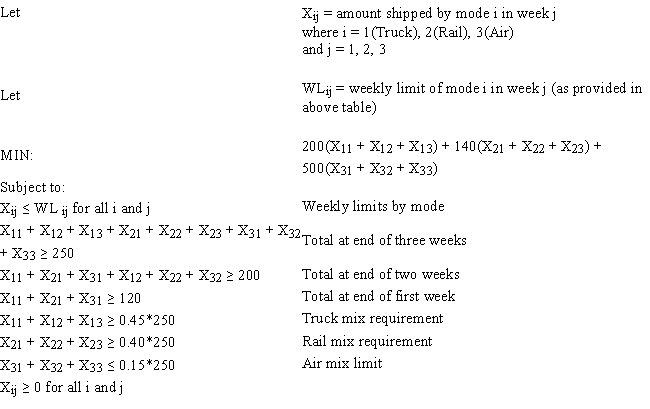Exhibit 4.1
The following questions are based on the problem below and accompanying Analytic Solver Platform sensitivity report.
Carlton construction is supplying building materials for a new mall construction project in Kansas. Their contract calls for a total of 250,000 tons of material to be delivered over a three-week period. Carlton's supply depot has access to three modes of transportation: a trucking fleet, railway delivery, and air cargo transport. Their contract calls for 120,000 tons delivered by the end of week one, 80% of the total delivered by the end of week two, and the entire amount delivered by the end of week three. Contracts in place with the transportation companies call for at least 45% of the total delivered be delivered by trucking, at least 40% of the total delivered be delivered by railway, and up to 15% of the total delivered be delivered by air cargo. Unfortunately, competing demands limit the availability of each mode of transportation each of the three weeks to the following levels (all in thousands of tons):  The following is the LP model for this logistics problem.
The following is the LP model for this logistics problem. 

-Refer to Exhibit 4.1. Are there alternate optimal solutions to this problem?
Definitions:
Conversion Costs
The costs incurred to convert raw materials into finished goods, typically including labor and overhead.
Direct Materials
Direct materials are raw materials that can be directly attributable to the production process of a product and are a critical component of manufacturing costs.
FIFO Process Cost Method
An accounting method that assigns costs to inventory on the basis of the first-in, first-out principle, particularly useful in manufacturing.
Work in Process
Inventory that includes the materials, labor, and overhead costs for products that are in the production process but not yet completed.
Q5: Which of the following are potential pitfalls
Q15: Refer to Exhibit 7.2. What formula goes
Q19: Christy is a telemarketer. She estimates that
Q26: The best models<br>A)accurately reflect relevant characteristics of
Q36: The third step in formulating a linear
Q53: Refer to Exhibit 11.7. What formula should
Q56: The standard prediction error is<br>A)always smaller than
Q89: Ebay is an online auction site where
Q109: Moral hazard occurs because people act<br>A) in
Q138: Private information<br>A) creates moral hazard but eliminates